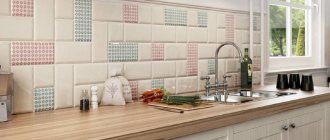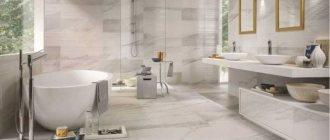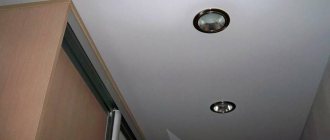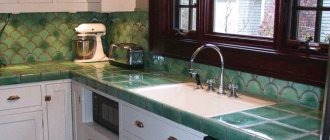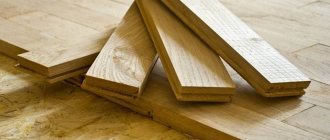The style of home design begins from the entrance area. You shouldn't literally finish the hallway first. However, it is important to remember that poor execution of the floor and other parts of the corridor will destroy the integrity of the interior of the entire apartment. An effect such as the first impression is also formed by the hallway, and gender plays a key role in this perception. Tile is the preferred option for finishing a room. It is easy to clean and tolerates temperature contrasts well when opening the front door. Moreover, it copes perfectly with the load from moving bulky objects. Tiles are now made in different colors, styles, textures and shapes; monotonous tiles are a thing of the past. Functionality and creativity are components of a successful tile choice. By modern standards, ordinary ceramic tiles on the floor in the hallway are a stylish and reliable option.
Requirements for hallway flooring
The floor in the hallway constantly gets dirty, and in winter it is subjected to pressure from heavy shoes. Sand, salt, snow and water come from the street 365 days a year. In this regard, the type of coating is chosen before the main part of the renovation and before the start of decorating the room. Requirements for floor finishing include high strength, moisture resistance, ease of maintenance, resistance to stains and dirt accumulation. Experts add to the general recommendations such a parameter as durability, in other words, wear resistance. The most unsuitable types of flooring include natural parquet boards and artificial parquet. The floor made from the listed materials gradually deforms due to contact with water. At the same time, ceramic tiles, porcelain tiles and linoleum are considered the best options.
Features of choice
Due to its high operational qualities, tiles are the best flooring for a corridor. Let's look at the pros and cons of using one type or another. This type of tile, such as porcelain stoneware, is not afraid of sharp heels. It is quickly and easily put in order.
Ceramics for finishing the floor in the hallway.
To prevent injuries, the floor tiles in the hallway should not be slippery. The choice of anti-slip coatings is huge.
The corridor area is characterized by the accumulation of dirt. Therefore, do not choose tiles with a strong relief structure.
Any flooring in the hallway can be cleaned using household chemicals. Porcelain tiles in dark shades with texture will make cleaning easier. The joints of the slabs should not be made light-colored. Over time they become dirty and will be difficult to clean.
Porcelain tiles are more impact resistant and practical to use.
Glazed and polished porcelain tiles create the effect of luxury, but in the area of the front door they will be hazardous. In this space, cladding with relief tiles is preferable.
Advantages and disadvantages
The first useful feature of the tile is its adaptability to conditions of increased pollution. The smooth surface is also easy to clean. With high-quality and dense installation, the tile covering exhibits increased resistance to impacts and heavy loads. Fireproof properties are guaranteed by the surface structure. For hot regions with a high risk of wildfires, it is important that flames cannot spread on the floor. In addition, the tiles cool the room on the warmest summer days, both in the north and south. Repairing a fragment of a tile composition is much easier than restoring the integrity of alternative types of coatings - another plus. Thanks to environmentally friendly materials, tiles do not pose any threat to human health. Some points are still negative. However, there are not many of them: poor sound insulation, slippery surface, possible violation of integrity due to poor installation.
The finishing materials market has long had tiles with a coating that prevents slipping and reduces other defects to a minimum.
Color and texture of cladding
On a surface that is too dark or light, all the dirt is visible.
Mosaic tiles 41.8x41.8 cm from Uralkeramika (Russia), Prague+ collection.
In order not to scrub the floor every day, it is better to choose a medium shade. Less dirt is visible on a mottled, textured surface.
For the floor in the hallway you need to choose matte dark tiles. It will not be slippery, and stubborn dirt will not be visible for a long time. It is easy to slip on wet glossy tiles, and when the top layer of enamel wears away, light bald spots will appear.
Don't be afraid that the floor will look like a train station. Now there are many beautiful collections of porcelain tiles for the floor in the corridor, inspired by wood and natural stone. A tile floor is primarily a background for the interior. He doesn't have to be beautiful or attract attention. It just needs to be comfortable and not spoil the look.
Italian Gambarelli porcelain tiles, Latino Multicolor collection. The size 15*15 and the combination of colors make the coating not boring.
Types of floor tiles in the hallway
The main options are ceramic, quartz vinyl tiles, and porcelain tiles. The first variety is classic, with good hygiene and durability. The second option is an improved material made from several layers. The third subspecies has a granular structure and decorative properties. There are also alternative options for decorating the floor in the hallway. Clinker tiles, for example, are known for their high resistance to low temperatures. Terraglia is white in color, so it is suitable as a basis for drawings. Cotto tiles have a brick tone and are a great option for an antique look. Metlakhskaya is an unglazed pressed tile of one-time firing. It is painted through and through, so the designs are especially durable. To finish the floors in the hallway, tiles with a solid and porous base, as well as with mono- and bicottura technology, are used.
Ceramic
One of the most popular materials for flooring. Ceramic tiles demonstrate high levels of hygiene - dirt does not adhere well to its surface. The tile is resistant to abrasion and can have decorative qualities. The surface itself is not only matte or glossy. Now on sale there are lapped, polished, embossed and glazed options. In addition, there are about ten types of ceramic tiles, depending on the material and manufacturing technology. According to the moisture resistance parameter, only 3 categories are distinguished. Low moisture absorption corresponds to high frost resistance, therefore, the tiles of the first group are of the highest quality, while the second and third groups have average and low performance. In addition, ceramic tiles do not conduct electricity and are resistant to fire. The use of this option is justified not only in the hallway, but also in the kitchen.
Porcelain tiles
An excellent finishing material for giving the room “individuality”. In addition, properly installed porcelain tiles will eliminate any surface imperfections. The cladding made of this material tolerates mechanical stress well. According to the Friedrich Mohs scale, different types of porcelain stoneware have strength from 5 to 8 points, with an average of 7. The material is “not afraid” of chemical reagents. You just need to avoid contact with hydrofluoric acid on the surface. Porcelain stoneware finishes can withstand frequent temperature contrasts, which makes the characteristics of the material optimal for hallways. Manufacturers produce products with thicknesses from 7 to 30 mm for different conditions, so there is an option for every case. The most popular sizes of porcelain tiles are 30×30 and 60×60 cm. When choosing cladding among this subtype of tile, complete consistency with the style of the room is important.
Quartz vinyl
This type of tile is created using elastic and hard material and is an improved type of PVC coating. Despite their intended purpose for places where there are large crowds of people, tiles are used to decorate floors in hallways and long corridors. Quartz vinyl is a combined material of several layers. The first layer is polyvinyl chloride (PVC), which ensures reliable adhesion to the surface being treated. Next comes glass fiber to increase the maximum load-bearing capacity. The third layer consists of quartz and vinyl - reinforces and gives strength. Above are the decorative layer and the protective polyurethane layer - the top one. Quartz vinyl tiles are easily restored after damage, can be used with electric floors and have a number of other advantages. Among other things, the material insulates sound better than other types of tiles.
Ceramic tiles in the hallway
We choose a surface that can be easily washed for a small space near the door.
Ceramic floor tiles for the hallway area are an excellent option. It is obtained by pressing and firing. This manufacturing technology gives it many advantages over wood materials, including moisture resistance, wear resistance and easy maintenance. The protective surface coating of ceramics is glaze, which increases strength and adds color.
The design will only benefit from the glaze, and the surface is protected
Attention! There are ceramic floor tiles and wall tiles. You should not confuse them, because tiles are designed for less intense loads and have a fragile porous structure.
The corridor always undergoes intense loads.
No coating will last as long in a hallway, kitchen, or bathroom as floor tiles. But there is one drawback: it has a cold structure to the touch, which can cause discomfort. This problem is often solved by installing underfloor heating systems. In turn, they function most efficiently with it because they conduct heat well.
A clear boundary separating the laminate corridor from the shoe area
There are other options. For example, do not lay ceramics over the entire corridor, but only use it for a small area near the front door. This will also clearly establish the boundary over which dirt should not cross.
The texture of wood on ceramics looks natural
Warm, not tactilely, but visually – an imitation of wooden coverings that will remove the “coldness” of the room. Manufacturers of porcelain stoneware have succeeded well in this, the strength of which allows them to make elongated tiles that imitate the slats of laminate and parquet.
Color design
There is a clear rule for choosing colors for the lower part of the room: the floor is decorated in darker colors compared to the general range. In the case of a corridor, the need to mask dirt and large amounts of dust is added. On tiles that are too dark in color, streaks will be visible, which is also bad. The tiles in the hallway are in harmony with the furniture with linear features in a lighter tone and in a medium-bright tint palette. A combined design with alternating slabs of light and dark colors is an acceptable way to expand the space. Another use for flooring color is to complement the masonry or wall pattern, if any. The color and texture of wood or stone are winning options in terms of practicality and design thought. At the same time, you can implement any style - from rustic to classic. Rich lighting is added to the color scheme to make the interior expressive.
The best colors for flooring:
- brown;
- grey;
- dark beige;
- ecru.
Floor tiles for the hallway and kitchen. Photo illustrations of interior design options
The color of the selected floor covering directly depends on whether the room being decorated has windows and where they open. So, if there are no windows in the corridor or they are facing north, then it is better to give preference to plain light tiles. A dark coating will take in too much light. If the windows in the room face south, you can use more saturated colors.
For a small kitchen it is better to use medium or small tiles
When choosing the size and shape of the tiles, it is important to consider the area of the room. Large square tiles are perfect for a spacious kitchen or hallway, and, for example, using rectangular tiles you can visually lengthen a short corridor. Looking through photos of floor tiles for the hallway, you will see examples of such work with space.
Using floor tiles you can create a unique interior design
For designs with ethnic motifs, a variety of patterns and ornaments are perfect; in rooms decorated in a minimalist style, it is preferable to use tiles with a monochrome surface, and in a modern interior, bright colored floors would be appropriate.
The ideal solution would be to install a “warm floor” system under ceramic tiles.
Helpful advice! To prevent the floor from looking monotonous and boring, you can combine large tiles and small decorative tiles with an interesting pattern. Such small original inserts can be made both in the center of the room and by distributing them evenly between monochromatic areas.
Various uses of multi-colored floor tiles in kitchen design
Tile texture
There are options for wood, stone, brick, as well as mirror surfaces and imitation minerals. Natural stone tiles will be needed to embody the style of modern and rustic interiors. Tiles with a fine-grained texture and smooth stone pattern will be appropriate in almost any setting. Terracotta tiles imitate a monotonous reddish stone surface. The “ragged stone” texture depicts the surface of a thick, chipped stone. There are also many options for wood. The texture imitating chipped wood is an excellent companion for a loft-style interior. Neat concentric circles on the tiles will harmoniously fit into the “Scandinavian” decor. Mirror tiles, as well as imitation chrome surfaces, are suitable for arranging a beautiful corridor with designer furniture. Such options are also useful for housing in high-tech, glamor and avant-garde styles.
Color variations
Interesting tile design for the hallway floor.
Light shades for the corridor are impractical. Especially the presence of texture will lead to clogging of the tiles and seams with dirt and to frequent treatment with abrasive agents. On a dark surface with deep shades, scratches and dust will be visible. Black color is not acceptable at all. Cool shades visually increase the area, while warm shades make the room cozy. The color palette of the slab for the corridor should be in unison with the flooring throughout the house/apartment. On the contrary, zoning can be enhanced through color contrast.
The combination of colors in the flooring for the hallway.
If the corridor is small, then multi-color flooring will further reduce the area. The ideal colors to use are beige, gray and coffee with milk. Alternating stripes of dark and light tiles also expands the space of a narrow corridor. Combining white and black areas has its own rules. When the hallway is small, light colors predominate. The large one has black tones.
Patterns
Using patterned floor tiles is beautiful and practical.
The large area of the corridor makes it possible to let your imagination run wild in laying out a pattern that immediately captures all attention at the entrance to the house. The panel in the center looks original, with mosaic edging on the sides.
The pattern on the floor itself should be in harmony with the pattern on the wallpaper, ceiling or furniture. The design style of the entire house is taken into account. The classic style uses marbled tiles. In a corridor with a predominance of oriental features, tiles with ornate patterns look appropriate. Tiles with contrasting shades, laid out in a checkerboard pattern, decorate homes decorated in high-tech style.
Shape and size
Main varieties by shape:
- rectangular;
- square;
- curly;
- polygonal.
Figured tiles have many options with different silhouettes. The finished floor will become the “calling card” of the apartment and design ideas can be planned around it. As for sizes, the typical parameters are 10×10, 10×15, 20×20, 20×25, 20×30, 30×30, 35×35 and 40×40 cm, that is, square and rectangular options. Proportions 1:2, 1:3 and “sticks” are also common. For hallways, it is important to use large-sized specimens of 70×120 and 60×100 cm. Due to such large masonry, the corridor visually expands in size. The layout itself is calculated down to the smallest detail, so that there are no cosmetic defects later. In addition, a successful configuration will prevent large waste of material that occurs when laying large tiles. The original shape also requires diligence when composing the tile combination.
How to choose tiles and laminate for the hallway
The selection of materials for finishing the floor in the hallway is somewhat different from the rest of the apartment or house. Of course, you can choose marble tiles and expensive premium class 34 laminate, but such a solution, even with significant financial expenses, does not always turn out to be the best in practice.
To select the right material, you must adhere to two requirements:
- The combination of tiles and laminate should provide protection from moisture and dirt, and safety in the hallway. Details such as comfort are usually paid less attention to, since the apartment owner spends only 1-5% of their stay in the entrance hallway;
- A professional combination with the interior of the hallway. The floor in the hallway remains an element of the furnishings and design of the entire living space, so you have to look for the most stylish flooring design options.
Important! The floor in the hallway, like the front door, can be called the hallmark of the apartment.
When entering a room, a guest or visitor automatically glances at their feet, so the design style of the corridor, walls and flooring turns out to be an even more powerful argument than the technical characteristics of the same tile or laminate. But any homeowner should have a general idea of what type of slab and slats are installed in the hallway.
Laying tiles in the form of a honeycomb requires the experience of a master.
Choosing a tile
If you are looking for a material with the highest durability, then porcelain stoneware will be the best option. If for the floor in the kitchen or in the hall, on which you walk in slippers or shoes with soft soles, you choose tiles of class III wear resistance, then porcelain stoneware is at least class five. It will last for 30 years of operation, even if the soil near the house is entirely sandy. Unfortunately, such finishing cannot boast of a variety of colors and patterns; usually these are monotonous black, gray, brown tiles with jasper or granite texture.
The optimal tile option for combination with laminate is wear resistance class IV. This is enough to withstand the load from shoes with hard soles and even metal heels. The hardness of tiles is usually chosen within 7 units, this is enough to avoid painting the surface with gravel and ash chips, which are abundant on the streets in winter.
Sometimes soft tiles based on terracotta or sandstone are used for the entrance area in the hallway. The soft, non-slip and at the same time very beautiful porous surface wears out quickly, becomes dirty, and therefore requires constant care.
Selection of laminate coating
For hallways, one type of laminate is suitable, this is a coating of class 33, or in the European classification AC5. The thickness of the melamine or polyurethane film reaches 0.8-1.0 mm, which allows the material to be used even under conditions of severe abrasive wear.
The thickness of the lamella is 10-12 mm, so the material can be laid on a wooden floor even without plywood underlays; you just need to level and sand the joints and lay the underlay in two layers of polystyrene foam.
Vinyl materials
PVC-based tiles and laminates have been used for a long time; they are excellent as flooring in the kitchen, bathroom and even living room. The slabs turn out to be too soft for finishing the entrance to the corridor; the surface quickly becomes covered with scratches and darkens.
Quartsinil is easy to install even for a beginner
You can use vinyl and quartz vinyl laminate. It can be laid directly on the self-leveling floor or screed poured under the tiles. The material does not require insulation or substrates; with regular cleaning of water, PVC lamellas can last no less than a conventional cellulose-based laminate.
Laying method
The standard “in-line” method is the simplest and most popular solution. The tiles are placed in even rows perpendicular to one and parallel to other walls, and even in a room with an irregular shape, the evenness of the masonry will be visually observed. The coating is as reliable as possible. The diagonal laying method provides for a certain inclination of the pattern in relation to one of the walls. In this case, the optimal value is 45°. The peculiarity of the inclined pattern is the difficulty of applying markings. However, such a pattern is indispensable for rooms with a large curvature of the floor. The staggered laying method, in turn, involves displacement of the joints. A monotonous option is possible with moving to the middle of the length of the adjacent tile and a method of creating short intervals that visually form a diagonal. Herringbone laying is a decorative option. Either triangular vertices are created, or a cascade with small elemental inserts - attachments.
The most original option is modular masonry, suitable for a designer room.
Layout
|
|
In the best case, the floor tiles in the hallway and in the kitchen should lie in one “canvas” without transitions. The worst option is to separate the tiles in the hallway area from the rest of the covering with a threshold. You will constantly trip over it, have trouble with pruning, and dirt will get stuck in there.
Beautiful, but not practical. Inconvenient threshold. The white grout has already turned black.
|
|
|
|
Porcelain tiles for parquet 20x60 cm Vallelunga Ceramica (Italy), Bois De Rose collection.
Square brown tiles are laid diagonally.
Russian tiles are cheaper, but have a simple design and problems with geometry and size. It is better to take Spanish, Portuguese, German and Italian tiles.
One color and standard layout - an option for everyone. Incorrect placement resulted in a narrow trim along the edge and ruined the entire look.
Layout of clinker tiles in the corridor with an offset (under brickwork).
Clinker floor tiles for a brick corridor. Herringbone layout with a border around the perimeter.
Clinker tiles and bright walls in the hallway.
Style solutions
Basic styles for decorating the floor in the corridor:
- Classical.
- Modern.
- Scandinavian.
- Loft.
- High tech.
Among them there are 3 “general” ones: classic, modern and hi-tech. Scandi and loft, in turn, are suitable for decorating original themed housing. As for the basic techniques for using tiles to decorate a corridor/hallway, we can distinguish 4 main areas. The first approach is standard. Select tiles of rectangular or square shape, one or several shades. At the same time, the color is consistent with the interior of the room and the entire home as a whole. The second option is to create drawings in the form of some abstract forms. The third installation method is somewhat similar, implying the presence of a certain type of pattern on each tile. The most original solution lies in using tiles with a certain texture or print. Including wood, stone, mirror surface, textile, metal. The transmission of each style can be enhanced by tiles with a textured surface.
Classical
Classic style includes the concepts of tradition, luxury and historical motifs. An expensive interior looks pointless in a cramped corridor. Otherwise, it's worth the effort. For a classic design, choose glossy tiles, porcelain tiles, and patterned elements. Design in a modern manner involves a light or reddish cladding with a moderate amount of decorative techniques. Creating a closed, dark-colored geometric shape on a light tile is just one of those. An additional option is a repeating pattern on a light or dark background, and in the second case it is better to choose brown, green or red. The cost of tiles for the implementation of classics will be many times higher than for a simple interior. You need to choose the right lighting fixture to match the glossy surface of the tile.
Modern
The style of the new era is based on the beauty of practical solutions. To match the style, it is necessary to comply with the general shape and concept of the room. Preference is given only to the most comfortable materials. Ordinary ceramic tiles can be “diluted” with small inserts. The main blocks are selected either monotonous or with a simple geometric pattern. Light and dark floor design options are good in their own way, but the second one is more justified. There are still no significant restrictions on color. Almost any of the most popular colors will do. In modern design there is also room for experiments that contradict generally accepted norms. Small light tiles surrounded by dark walls, a completely black floor with white walls, multi-colored mosaics, monotony, sharp contrasts and other options are acceptable if you follow one main rule - proceed from practicality. Almost any material will do.
Scandinavian
The owner of the living space usually has two options. Scandinavian style, on the one hand, goes well with a light brown floor, but on the other, it requires as many white surfaces as possible with a minimal shift towards some shade. Accordingly, the choice is between two options. The region of origin of the style is deprived of sunlight 150-200 days a year, and therefore visual lightening through surfaces and artificial objects is important. White glossy tiles, monotonous or with small geometric elements in bright colors, are an option for maximalists. This coating diffuses sunlight well and is suitable, in particular, for small hallways. This way the whole essence of the Scandi style is conveyed. A more trivial and far-sighted way to solve the housing problem is to decorate with tiles that imitate wood. In this spirit, you can decorate not only the floor, but also one of the walls, for example, behind a set of furniture. You will get a color distinction along the diagonal.
Loft
Stylistics is absolutely deservedly popular, because it allows you to compensate for some of the shortcomings, and even turn some of them into advantages. The style is characterized by dark and dirty tones, just the kind needed to hide stains. In addition, the loft style necessarily contains expressive textures. If the residents have old tiles, then with the overall design for a loft they will take on a current and modern look. A tile that imitates natural and industrial materials is ideal. For finishing, one or more types of coating are used - stylistics do not prohibit this approach. Graphite tiles, for example, are used to recreate the color of asphalt. A “softer” version is wood-look tiles. If in the first case we are talking about a “screaming” design, then in the second - about home comfort, “lamp-likeness”.
High tech
Strict tones prevail in the style. The direction itself primarily embodies the desire for technological capabilities and congenial design. Modern and traditional design methods are encouraged. Matte and glossy tiles of deep color are also suitable. On paper, you can try an option with a combination of tiles of different sizes. The easiest alternative to looking for an original design is large, single-color elements. The monochrome palette only at first glance makes the task of decorating the hallway easier. Based on the principles of stylistics, we need modern materials and complete harmony with interior objects and walls. At first, any option will seem better than it actually is, because the tiles will need to be combined with metals, mirrors, glass and various panels. The interior in the high-tech style is complex in execution, so the help of an expert will not hurt.
Which is better - tiles or laminate in the hallway?
The easiest way is to do it the old fashioned way, the threshold is made of tiles, and the rest of the hallway floor is finished with laminate. But the design of old schemes already looks rather dull, and most apartment owners would prefer to see a comfortable and at the same time beautiful floor on the floor in the hallway. You can use just one material. Moreover, laminate and tiles have their own strengths:
- The tile is extremely resistant to abrasion, which is especially important for houses and apartments on the first floor, where the exit from the hallway leads directly to the street. A huge amount of dust, salt and sand that gets into the room on the shoes of residents can erase the decorative layer on the floor to the ground in a few months;
- Laminate provides maximum comfort even after rain and snow; drops of water on the laminated floor do not make the coating slippery and traumatic. The slats retain heat well, dampen noise and sounds, while the tiles only reflect and enhance them.
Both types of flooring can be equally effective from both a decorative and utilitarian point of view. If the house does not have a porch area, then the best solution would be to use quartz vinyl tiles or very expensive class 33-34 laminate in the hallway. In all other cases, either laminate flooring or regular tiles can be used.
Advice! You should not compare finishing the corridor with laminate and tiles. Both materials have approximately the same positions, so it is not recommended to buy and install tiles just because you like the color.
It might make sense to try using a combination of tiles and laminate in the hallway. Both materials are available in a huge range of textures and colors. If previously slats were made exclusively with an imitation of wooden or parquet flooring, today there is a huge number of textures of a wide variety of types, from granite to lemon wood. The floor in the hallway made of laminate and tiles, photo, can look very unusual and stylish. At the same time, it remains possible to replace one of the coatings if the design of the room needs to be adjusted or updated.
Classic entrance door design
Combined floors in the hallway: what can you combine tiles with?
Among the combined materials it is worth noting:
- laminate;
- parquet board;
- wooden board;
- clapboard or linoleum (less often).
If the transition between coverings is properly designed, tiles can be combined with any type of facing materials. A combination of different coverings will most likely spoil a small corridor, but in a large hall it will be organic. Laminate is most often combined with tiles. The tile covering is placed next to the entrance. After the diagonal joint, a neat gap is made and then the rest of the floor is finished with laminate. Some people make the mistake of separating the two coverings in the middle of the hallway with a plank. In fact, its installation is only permissible at the entrance to a narrowed/expanded part of the room or on the threshold between the hallway and another room. Parquet and wooden boards are used less frequently. These materials go well with wood-effect tiles. When arranging a combined floor covering, 3 rules must be followed. Firstly, the transition is made diagonal, rounded, polygonal or in the form of a peninsula, but not a straight line. Having contrast is the second rule. Colors are selected in a neutral range.
Combined floors - what and how are floor tiles combined with?
If the floor of the corridor is decorated only with tiles, then it will look a little boring, especially if it is large and the blocks are laid out in rows. You can diversify it by combining tiles with other floor coverings. This option has several advantages:
If the tiles are laid directly on the threshold, the floor will be protected from excess dirt. Zoning is considered a fashionable trend of our time. The boundary of the hall or living area can be divided into dividing lines of different coverings.
The corridor can be relieved of monotony by combining different floor coverings. It’s easier to make straight-line transitions, although there shouldn’t be any particular difficulties with curly ones. Zoning with a podium will look impressive, where the tiled area will be slightly raised
.
Self-laying tiles on the floor in the hallway and corridor
Before laying, first level the floor and then check it with a building level. Once the installation solution has dried, priming will also be needed. The tiles must be laid according to pre-prepared markings, in parallel using spacer crosses at the intersections of the seams. The result will be beautiful, even rows. Some craftsmen recommend skipping the markings taking into account the dimensions, and instead suggest laying the covering from the corner. Immediately before laying, prepare the adhesive composition. It is applied to the floor with a smooth spatula, and leveled with a serrated one. To make the solution, it is enough to have a construction mixer or a special attachment for a drill. The composition is stirred until it becomes homogeneous. At the same time, you should not give a lot of glue at once, otherwise the mixture will dry out prematurely. It is better to stretch the process over 2-3 approaches. The substance is applied to no more than 1 square. meter, as well as for all tiles that will be placed on the treated area. The laid tiles are leveled with a rubber hammer.
For the next three days, the seams are moistened with water from a spray bottle.
How to prepare the base?
Before laying the tiles, you need to prepare the base appropriately. First of all, close all doors and existing windows - there should be no drafts in the room. Monitor the substrate temperature.
Be sure to ensure that it does not fall below +5°C.
Layout of materials.
The surface intended for masonry must be dry and clean. Be sure to work on this before you start. It is necessary to thoroughly sweep, or better yet, thoroughly vacuum the floors.
Traces of oils, paints and other substances must be removed, because... they will interfere with the normal adhesion of the mixture and the base. After some time, cracks, potholes and other defects may form in places with poor grip.
To get a high-quality base for tiles, you should take a level, use it to determine the difference in surface height and eliminate it by pouring a screed. Fill the surface with a thin layer of primer solution correctly prepared in accordance with the instructions. Smooth out the resulting drips and, if any, puddles. It is very important to prepare the mixture correctly. Be sure to follow the instructions on the package.
Pouring the solution begins immediately after preparation. Experts recommend doing this by forming strips about 50 cm wide with further distribution of the fill over the surface.
Pour the solution quickly but carefully. The thickness of the screed is also indicated on the packaging of the mixture. The floor dries in about 12 hours. After this, you need to wait another 2-3 days, and you can proceed to laying the tiles.
Tools required for work: tape measure, saw, level, tile cutter, scraper with attachment.
Before laying the tiles, prepare the tools for work:
- Adhesive solution.
- Tile cutter
- Bucket.
- Scraper with nozzle.
- A spatula.
- Roulette.
- Protective gloves.
- Level.
- Saw.
- Primer for floors.
- A rag.
Tips for choosing tiles for the floor in the hallway
First of all, pay attention to the general characteristics and performance. For the corridor, choose tiles with a solid base, because the porous coating accumulates moisture faster. The acceptable porosity is in the range of 3-6%. The lower value is relevant for large private houses. In apartments, a higher level of porosity is allowed. A less porous material is primarily stronger in bending. Porcelain stoneware and unglazed tiles are used to make masonry near the front door. Shoes do not slip on rough surfaces, and in this regard, the best options are those with corundum coating. The type of surface also matters: on a glossy surface, scratches and other mechanical damage are more visible than on a matte surface. A tile with a large, complex pattern will hide stains and stains after washing. Tiles should be selected from products with abrasion class 3 or 4.
Combining tiles with laminate
We have sorted out the advantages and disadvantages of the material, now the important issue is the ability to combine tiles near the front door in the hallway with other materials. As mentioned earlier, this can be done, in some cases it is even necessary if we are talking about a large hallway.
A successful combination can serve as a kind of zoning of space. For example, a good solution would be tiles near the entrance door in the hallway, while finishing the rest of the area with a different material. Thus, the ceramics itself will be in a zone of increased aggressive influence (at the same time, you don’t have to place a foot mat near the door), and at the same time it will become a signal that you can’t walk further in shoes.
Also, in some cases, additional zoning of the premises is necessary. For example, in a one-room apartment or studio, you can thus unobtrusively show the common area of the apartment and allocate space for the so-called hallway, which at the same time is part of the main room.
Another combination option is to make non-standard masonry from tiles of various shapes and frame the pattern with parquet boards, and this option looks especially good in combination with natural stone tiles, which adds elegance to the room. In addition, you can repeat the ceiling pattern in this way (in cases where there is a suspended or suspended ceiling with bends).
Also, the tiles near the door in the hallway can be laid out in the form of a podium, which will help with zoning, and in addition will more clearly highlight the line between materials. But we note that the elevation should not be more than a few centimeters, otherwise there is a high risk of falling and injury.
Advice from professionals
To avoid mistakes and rework after repair, use these useful tips:
- Before laying tiles, insulate the floor with an electrically heated system;
Heating system before laying tiles. - When calculating the required amount of porcelain stoneware, be sure to add 8 - 10% for trimming and fitting;
- When purchasing a large batch of material, check the number and color;
- Choose grout for joints “in color” or one or two shades lighter / darker;
- Seamless tiles are suitable for rooms with an area of 15 m² or more.
Thanks to its technical characteristics, porcelain stoneware is an ideal material for decorating the floor in the hallway. The appearance and service life of such coating will largely depend on the quality of installation. It may make sense to resort to the services of professional specialists.
